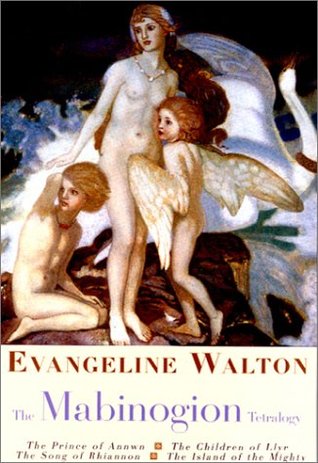Title: The Mabinogion Tetralogy
Authors: Anonymous, Evangeline Walton (translator), Betty Ballantine (Introduction)
Date Added: August 24, 2014
Date Started: July 31, 2016
Date Finished: May 6, 2017
Reading Duration: 281 days
Genre: Mythology/Welsh Mythology/Celtic Mythology/Irish Mythology, Fantasy, Classic
 Pages: 720
Pages: 720
Publication Date: April 1, 1980
Publisher: The Overlook Press
Media: Paperback
Shares Paradigms With: The Chronicles of Prydain, The Raven Cycle
The retelling of the epic Welsh myth that is “certainly among the top 5 fantasy series of the twentieth century” (sfsite.com).
The Mabinogion is to Welsh mythology what the tales of Zeus, Hera, and Apollo are to Greek myth. these tales constitute a powerful work of the imagination, ranking with Tokien’s Lord of the Rings novels and T.H. White’s The Once and Future King. Evangeline Walton’s compelling rendition of these classic, thrilling stories of magic, betrayal, lost love, and bitter retribution include the encounter between Prince Pwyll and Arawn, the God of Death, which Pwyll survives by agreeing to kill the one man that Death cannot fell, and the tale of bran the blessed and his family’s epic struggle for the throne.
The Mabinogion is internationally recognized as the world’s finest arc of Celtic mythology; Walton’s vivid retelling introduces an ancient world of gods and monsters, heroes, kings and quests, making accessible one of the greatest fantasy sagas of all time.
******Warning: Some mentions of rape as it pertains to the narrative.******
I first cut my teeth on Welsh Mythology with The Prydain Chronicles of Lloyd Alexander, books written for children, and rife with the myths of that land. It was where I first saw the name “Gwydion” and heard the term “Son of Don” and “Math Son of Mathonwy.” At the time I though Don and Mathonwy were the names of their fathers since lineage now and still flows through the father, but at that point in the history of Wales, the name of the mother was the line of kings.
Prydain did an excellent job of introducing the rich mythological history of Wales, and Mr. Alexander (who is actually from around my area) cited the Mabinogion as one of his sources, but as it was a children’s book, The Chronicles barely scratched the surface of the myths’ depths. Though I read the series years ago (and haven’t had a chance to reread it again), I remembered the name of the source, and when the opportunity presented, obtained a copy of the volume in question.
The Mabinogion Tetralogy is so named for the four sections or “branches: that make up the compendium. Unlike most mythology collections, it doesn’t consist of numerous short stories of similar theme, but rather of longer tales broken up into chapters. Each branch is further delineated into books, and while each book has a slightly different plot, each branch deals with the same characters, and some of them step between the tines and into other sections.
The first branch Prince of Annwn deals with the titular Pwyll’s descent into the underworld due to his bargain with Arawn, the Grey Man and keeper of the dead during the aptly named Descent into the Abyss. While the second book, Rhiannon of the Birds recounts how Pwyll managed to marry a woman from another (faery) realm. The Abyss played host to some startling horror elements, darker than normally seen in mythological text, but apt for where the prince of Dyved found himself.
The second branch is called The Children of Llyr, and it has no subsections (to go back to Mr. Alexander’s work, the third book in his Prydain Chronicles was titled The Castle of Llyr). Concerning Bran, king over the Island of the Mighty, and his siblings full and half, we’re also introduced to the matrilineal customs of the Old Tribes (as opposed to the patriarchy of the New, which the first branch focuses on).
Branwen, Bran’s sister, marries an Irish lord and goes with him back to his island to bear the son that will eventually rule in Bran’s place (like Math is the Son of Mathonwy and Gwydion is the Son of Don, the heir to the king is his eldest sister’s son), but he abuses her at the encouragement of his advisors, forcing her to be a scullery maid, and this eventually leads to war with Wales. By the time this branch comes to an end, only one of the siblings is left. Many die from war and treachery and one dies of grief.
Despite this woe (or perhaps because of it) The Children of Llyr was the best part of the compendium closely seconded by the next, The Song of Rhiannon, which follows directly from with the remains of that family: Rhiannon (the lady out of faery), and her son Pryderi by Pwyll (from the first branch).
Even though the branches might appear disparate, they are all connected with each bleeding into the other like the future from the past even the fourth The Island of the Mighty, which concerns completely different characters entirely at least upon first glance. Pryderi makes an appearance in this final section, but as an antagonist to the people initially introduced. This was my least favorite section as the very first plot concerns Gwydion’s younger brother Gilvaethwy and how seemingly lovelorn he is for Goewyn, his uncle the king’s royal footholder, but it’s not “love” he’s looking for.
Though I was familiar with Gwydion from The Prydain Chronicles, he was not the character here that he was there (though still a powerful druid), and the fore mentioned catalyst for the narrative left a bitter taste in my mouth and rage in my heart as the heir to Math helps his brother rape the king’s virgin foot holder. While Goewyn becomes queen due to that act, so married to Math by his behest, and both brothers are punished by being changed into beasts (due to their bestial behavior), there’s still a lot of problematic language around. Arianrhod, Gwidion’s sister, even victim blames the poor girl, though she, the Lady of the Silver Wheel, is essentially the villain of this branch. She attempts to stymie Gwydion’s efforts at every turn, though some of her reasoning makes perfect sense to me.
Gwydion’s heir would have to be a child of one of his sisters, and I’m assuming that it would be the oldest child of the eldest, but if she had no male issue, it would go down from there. He has other sisters, but for some reason he and Math feel the need to push Arianrhod who falsely claims to be a virgin. After Goewyn becomes queen, Math needs a new foot holder, and Arianrhod desires the position, but her uncle sets her a test, which she fails by instantly giving birth to a son, Dylan, who disappears into the sea. Then later, Gwydion has this chest which contains another child of Arianrhod. I’m not sure if it’s supposed to imply she gave birth prematurely (and unknowingly), but she not only wants nothing to do with him, she also lays three curses upon him, one after another as Gwydion figures out how to get around them. There’s also some weird, icky, potential incest between her and Gwydion, and I’m still not entirely unconvinced that the boy, who came to be named Llew, wasn’t his actual son.
The second and third branches were my favorite. The tales of Bran and his brethren were beautiful and heartbreaking all in one. The language so moved me that in some of the parts I read aloud just to hear the sorrow resonate and taste bittersweet on my tongue. If I were to reread any part of this compendium, it would be the tales of Bran, Branwen, and their brothers. There is a good chance George R. R. Martin borrowed from the mythology of the Welsh in order to craft his Bran(don) Stark of Winterfell in A Song of Ice and Fire, though whether he’s referring to the boy Bran of the current time or Brandons from the past remains to be seen, though it is also entirely possible that all Brans are the same. His name means “crow” or “raven.”
There has never been a mythology compendium like this, at least none I’ve ever read. Most of them consist of short stories not full narratives. This read more like a novel in three of four parts, though each part led from the one before. It would be possible to just read the first branch, the second and third branch, and the fourth branch separately (in fact, I think before the full Tetralogy was put together, they were sold separately), but you would miss out on the connections in between, similar to playing any Legend of Zelda or Final Fantasy game. The individual story will make sense, but understanding the connections between will enrich it.
The language is poetic and flowing, though there were some points where it felt even too heavy and pedantic for me. There were a few chapters in the fourth branch that I skimmed, because they didn’t really move the story forward, but for the most part The Mabinogion Tetralogy is an excellent resource for anyone interested in Welsh mythology, which seems to far less known than Classical, Egyptian, or even Norse. I would even more highly recommend it for anyone who read and enjoyed Lloyd Alexander’s The Prydain Chronicles as this was the source and inspiration of that award winning tale, and if you haven’t read Mr. Alexander’s work, well I highly recommend that as well.
4.5 stars.
Save
Save
Save
Save
Save
Save
Save
Save
Save
Share this:




